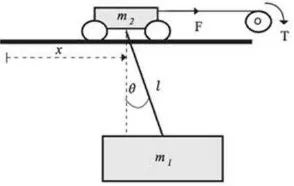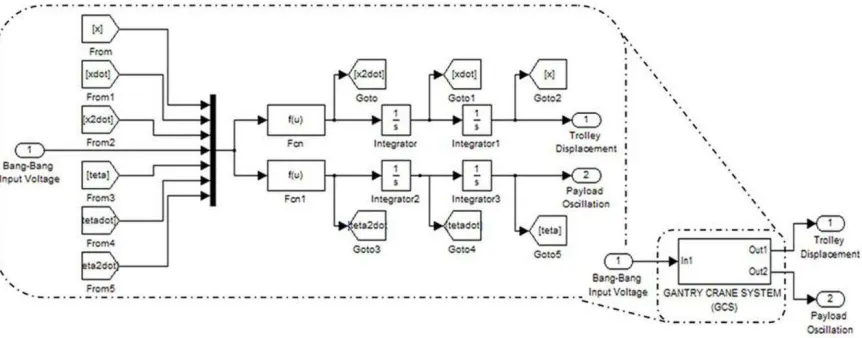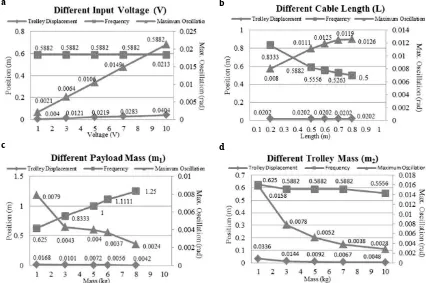Procedia Technology 11 ( 2013 ) 419 – 425
2212-0173 © 2013 The Authors. Published by Elsevier Ltd.
Selection and peer-review under responsibility of the Faculty of Information Science & Technology, Universiti Kebangsaan Malaysia. doi: 10.1016/j.protcy.2013.12.211
ScienceDirect
The 4th International Conference on Electrical Engineering and Informatics (ICEEI 2013)
Dynamic Behaviour of a Nonlinear Gantry Crane System
Hazriq Izzuan Jaafar
a*, Z. Mohamed
b, J.J. Jamian
b, Amar Faiz Zainal Abidin
b,
Anuar Mohamed Kassim
a, Z. Ab Ghani
baFaculty of Electrical Engineering, Universiti Teknikal Malaysia Melaka, 76100 Durian Tunggal, Melaka, Malaysia bFaculty of Electrical Engineering, Universiti Teknologi Malaysia, 81310 Skudai, Johor, Malaysia
Abstract
This paper presents investigations of dynamic behaviour of a nonlinear Gantry Crane System (GCS). The dynamic model is derived using Lagrange equation. Various system parameters of the system are tested to observe the actual behaviour of the dynamic model system. System responses including trolley displacement and payload oscillation are analyzed. Simulation is conducted within Matlab environment to verify the performance responses of the system. It is demonstrated that several factors affected the performances of the GCS in terms of input voltage, cable length, payload mass and trolley mass.
© 2013 The Authors. Published by Elsevier B.V.
Selection and peer-review under responsibility of the Faculty of Information Science and Technology, Universiti Kebangsaan Malaysia.
Keywords: Gantry crane system; Lagragian method; Modeling; Nonlinear model; Simulation.
1.Introduction
In our daily life, the strength of human is very limited and cause difficulties in handling with huge materials. In order to utilize of manpower, heavy machinery is needed to make the work become easier and less time to complete the task. Nowadays, the improvement of technology made Gantry Crane System (GCS) as one of the suitable heavy machinery transporter to be used in the industries. The purpose of GCS is to transfer variety of material from one location to another location in order to load and unload of huge materials where heavy loads must be moved with extraordinary precision [1]. It has been supported by two or more legs [2]. The trolley is designed on the top of GCS
* Corresponding author. Tel.: +606-5552358; fax: +606-5552266.
E-mail address: hazriq@utem.edu.my
© 2013 The Authors. Published by Elsevier Ltd.
to move and bring heavy loads either left or right along the horizontal bridge rail of a crane until accomplish to the desired location.
The crane acceleration is required for motion and induces undesirable load swing [3]. At higher speed, these sway angles become larger and cause the payload difficult to settle down when unloading. A lot of time is needed to unload until the payload stop from swaying. This unavoidable frequently load swing causes drop efficiency, load damages and even accidents. Due to this, most of the GCS is controlled by experts and experience operators manually in order to stop the swing and trolley at an accurate position. The vibration in the trolley and payload may affect the operator's safety and it would be more dangerous if heavy loads are increasing and will have a major impact on employee around the working areas [4].
This paper presents a development and investigations of nonlinear GCS model. The dynamic model of the system is derived using Lagrange equation. Thus, simulation is conducted within Matlab environment to verify the performances effect of various input voltage, cable length, payload mass and trolley mass on the dynamic behaviour of the system. Trolley displacement and payload oscillation of the system are observed and analyzed. Simulation results have demonstrated various responses with the different setting of the GCS parameters. This behaviour will be useful for development of efficient control algorithms.
2.Nonlinear Model of GCS
In this work, a schematic diagram of a Gantry Crane System (GCS) is considered as shown in Fig. 1. The parameter of GCS are represent as m1, m2, l, x,
T
, T and F which are namely as payload mass, trolley mass, cablelength, horizontal position of trolley, swing angle, torque and driving force respectively. The nonlinear model of GCS is modeled based on [5] and all the parameters value for the system is shown in Table 1.
Fig. 1. Schematic diagram of a nonlinear GCS [5]. Table 1. System parameters.
Parameters Value (Unit) Parameters Value (Unit) Payload mass (m1) 0.5 kg Resistance (R) 2.6 Ω Trolley mass (m2) 2.0 kg Torque constant (KT) 0.007 Nm/A Cable length (l)
Gravitational (g)
0.5 m 9.81 m/s2
Electric constant (KE) Radius of pulley (rP)
0.007 Vs/rad 0.02 m Damping coefficient (B) 0.001 Ns/m Gear ratio (z) 0.15
2.1.Mathematical modeling
i
where L, Qi and qi represent Lagragian function, nonconservative generalized forces and independent generalized
coordinate. The Lagragian function can be written as:
P T
L (2) with T and P are respectively kinetic and potential energies. This relationship is involved in calculating on how it is related to be more flexible coordinates. Kinetic and potential energies can be derived as:
T
Since the dynamic DC motor is included in this gantry crane model, differential equations with their effects is derived. By considering the dynamic of DC motor, a complete nonlinear differential equation of the GCS can be obtained as:
where V is an input voltage. Thus, these two equations are represented for this nonlinear GCS as shown in Fig 1.
3.Implementation, Results and Discussion
Fig. 2 shows a Simulink block diagram developed based on dynamic equations in Eq. (4) and (5). Bang-bang input voltage signal is applied as an input voltage and it has been set as ±5 Volts. A bang-bang signal has a positive and negative period that allowing trolley to accelerate, decelerate and immediately stop at certain position. Trolley displacement and payload oscillation are observed in order to analyze the performances response of GCS. All the parameters have been set up as in Table 1.
Several simulation studies have been performed to study the behaviours of GCS. Analysis with different system parameters has been conducted. Fig. 3 shows trolley displacement response with different values of input voltage (V), cable length (l), payload mass (m1) and trolley mass (m2). Similarly, Fig. 4 shows payload oscillation with
various system parameters. It is noted that the system dynamic behaviours are affected by the system parameters.
Fig. 3. Trolley displacement response with different setting of (a) input voltage; (b) cable length; (c) payload mass; (d) trolley mass.
Observation are then based on four criteria's which are the average position of trolley displacement, maximum oscillation of payload, period of one cycle of oscillation and frequency of the system. Table 2, 3, 4 and 5 summarise the simulation results. In addition, Fig. 5 summarise the results in graphical representation.
Table 2. Different setting of voltage input. Variable value of
Table 3. Different setting of cable length. Variable value of
Table 4. Different setting of payload mass. Variable value of
Table 5. Different setting of trolley mass. Variable value of
Several observations can be deduced from the results:
i) Greater distance can be reached by the trolley by increasing the input voltage. However, frequency of the system is not affectedby the voltage input while maximum oscillation of payload is linearly increased. ii) Distance of the trolley is not much affected by increasing the cable length. Nevertheless, frequency of the
iii) Distance of the trolley is affected by the payload mass. Larger mass of payload, lower distance can be reached. The frequency of the system is dependent on the payload mass. The bigger the payload, the frequency will be increased. However, maximum oscillation of payload is decreased.
iv) Lastly, distance of the trolley is affected by its mass. Larger mass itself, lower distance can be reached. The frequency of the gantry crane is dependent on the trolley mass where the bigger the trolley, the lower the frequency. The maximum oscillation of payload is also decreased.
Fig. 5. Effect of different setting of (a) input voltage; (b) cable length; (c) payload mass; (d) trolley mass. 4.Conclusion
This paper was investigated the development of a dynamic model and dynamic model of GCS. Nonlinear differential equations of the system have been derived using Lagrange equation. System responses including trolley displacement and payload oscillation have been examined. Various system parameters of GCS have been tested. Simulation results have shown that the performances response of GCS is very sensitive to the variation of parameter setting. These analyses are very beneficial for development of control algorithms for GCS.
a
c
b
References
[1] Maghsoudi, M.J., Mohammed, Z., Pratiwi, A.F., Ahmad, N., Husain, A.R. An Experiment for Position and Sway Control of a 3D Gantry Crane,”2012 4th International Conference on Intelligent and Advanced Systems; 2012. p. 497-502.
[2] Yusop, A.M., Mohamed, Z., Sulaiman, N.A. Inverse Dynamic Analysis with Feedback Control for Vibration-Free Positioning of a Gantry Crane System,” International Conference on Electronic Design; 2008. p. 1-5.
[3] Butler, H., Honderd, G., Van Amerongen, J. Model Reference Adaptive Control of a Gantry Crane Scale Model, IEEE Control Systems Magazine1991; 11(1): 57-62.
[4] Ju, F., Choo, Y., Cui, F. Dynamic Response of Tower Crane Induced by the Pendulum Motion of the Payload, International Journal of Solids and Structures 2006; 43: 376–389.




